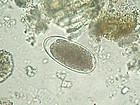Difference between revisions of "Trichostrongyloidea - Overview"
| Line 2: | Line 2: | ||
[[Image:Trichostrongylus.jpg|thumb|right|150px|''Trichostrongylus'' - Joaquim Castellà Veterinary Parasitology Universitat Autònoma de Barcelona]] | [[Image:Trichostrongylus.jpg|thumb|right|150px|''Trichostrongylus'' - Joaquim Castellà Veterinary Parasitology Universitat Autònoma de Barcelona]] | ||
| − | + | ==Introduction== | |
Trichostrongyloidea are a bursate [[Nematodes|nematodes]], with ''[[Dictyocaulus]]'' forming the only exception. Important genera include ''[[Ostertagia]]'', ''[[Haemonchus]]'' and ''Trichostrongylus.'' | Trichostrongyloidea are a bursate [[Nematodes|nematodes]], with ''[[Dictyocaulus]]'' forming the only exception. Important genera include ''[[Ostertagia]]'', ''[[Haemonchus]]'' and ''Trichostrongylus.'' | ||
| Line 14: | Line 14: | ||
Parasitic development initially occurs in gastric glands or intestinal crypts, species dependent. Adults are generally found on the mucosal surface, and the prepatent period is typically about 3 weeks. | Parasitic development initially occurs in gastric glands or intestinal crypts, species dependent. Adults are generally found on the mucosal surface, and the prepatent period is typically about 3 weeks. | ||
| + | ==Literature Search== | ||
| + | [[File:CABI logo.jpg|left|90px]] | ||
| + | |||
| + | |||
| + | Use these links to find recent scientific publications via CAB Abstracts (log in required unless accessing from a subscribing organisation). | ||
| + | <br><br><br> | ||
| + | [http://www.cabdirect.org/search.html?q=id:(%22Trichostrongyloidea%22)+AND+title:(%22life+cycle%22) Trichostrongyloidea life cycle publications] | ||
Revision as of 21:44, 5 October 2010
| This article has been peer reviewed but is awaiting expert review. If you would like to help with this, please see more information about expert reviewing. |
Introduction
Trichostrongyloidea are a bursate nematodes, with Dictyocaulus forming the only exception. Important genera include Ostertagia, Haemonchus and Trichostrongylus.
General Life-Cycle
The life cycle of Trichostrongyloidea is direct, and infection is through ingestion of L3.
The egg is approximately 80µm long, oval, thin-shelled, and containing 4-16 cells, so is a typical strongyle egg.
Egg → L1 → L2 → L3 occurs on the ground. L1 and L2 feed on bacteria, and L3 is exsheathed and represents the infective stage. L3 cannot feed, but do contain a finite amount of stored food to provide energy for movement. Infection is via ingestion of the L3. L3 → L4 → adult, these stages generally occur in the stomach or small intestine.
Parasitic development initially occurs in gastric glands or intestinal crypts, species dependent. Adults are generally found on the mucosal surface, and the prepatent period is typically about 3 weeks.
Literature Search
Use these links to find recent scientific publications via CAB Abstracts (log in required unless accessing from a subscribing organisation).
Trichostrongyloidea life cycle publications

